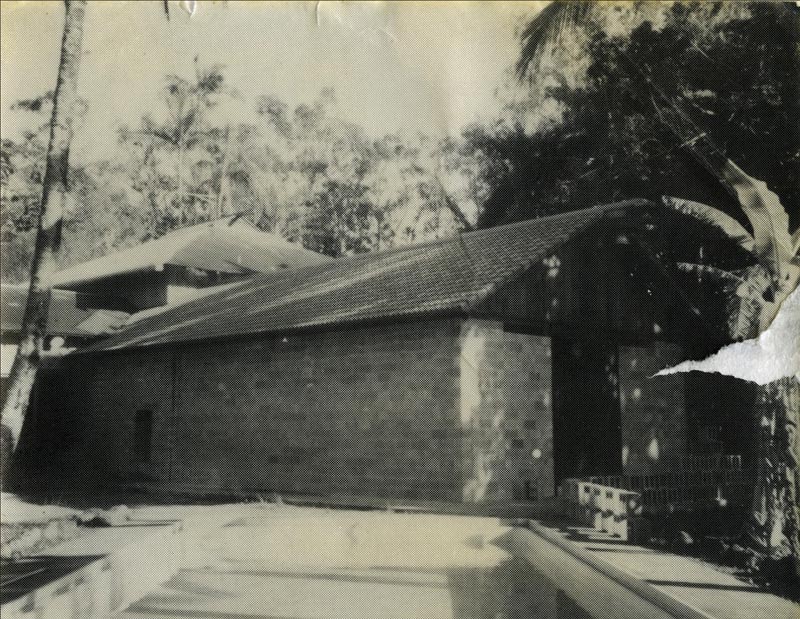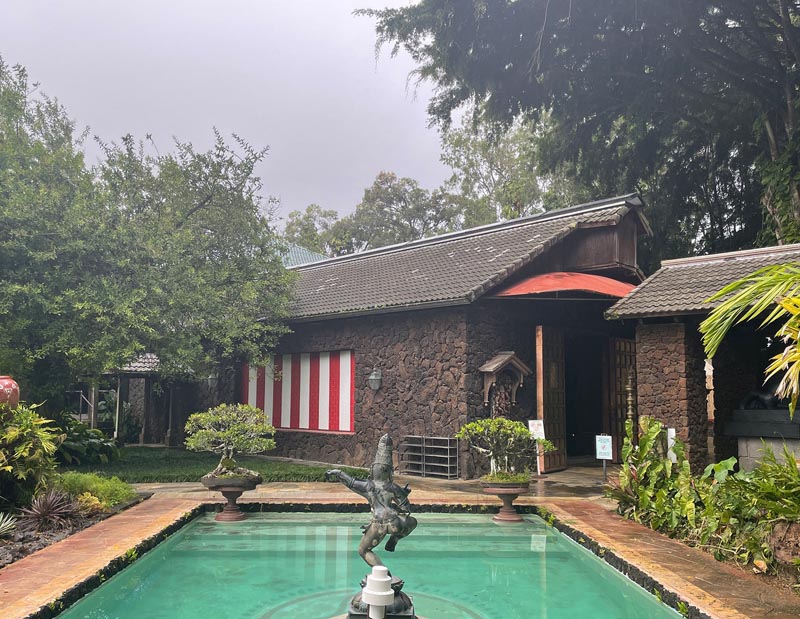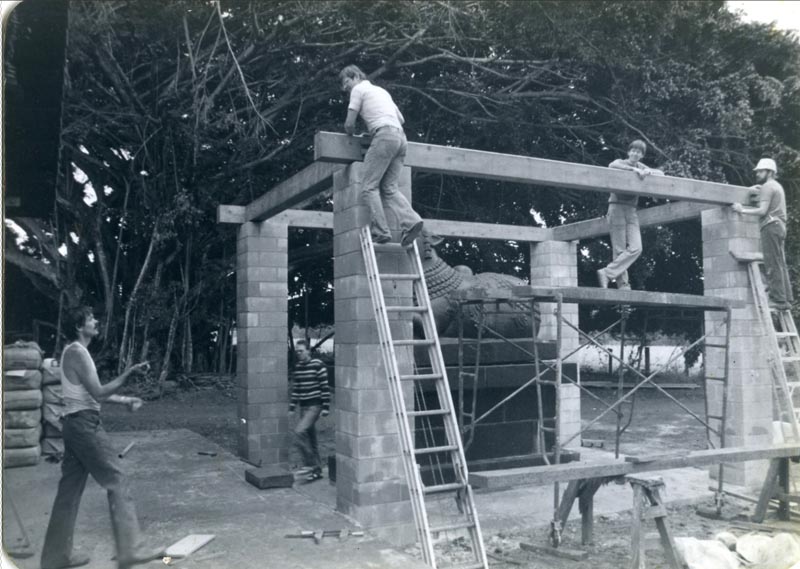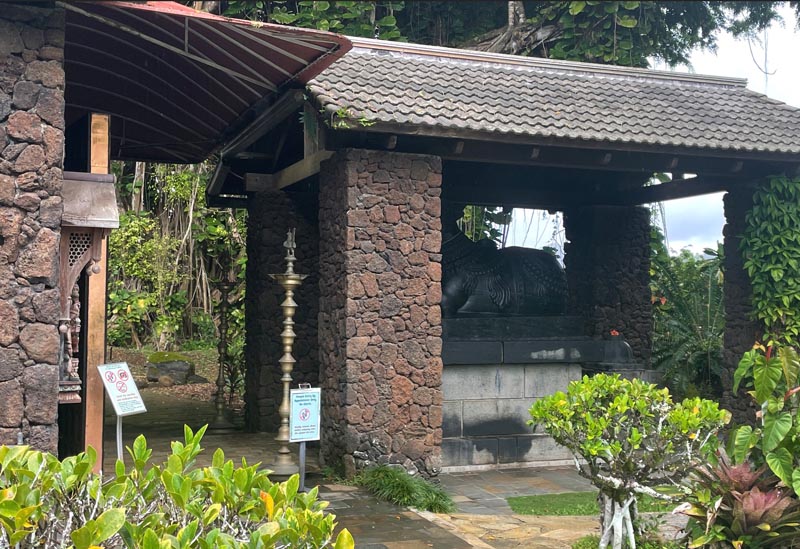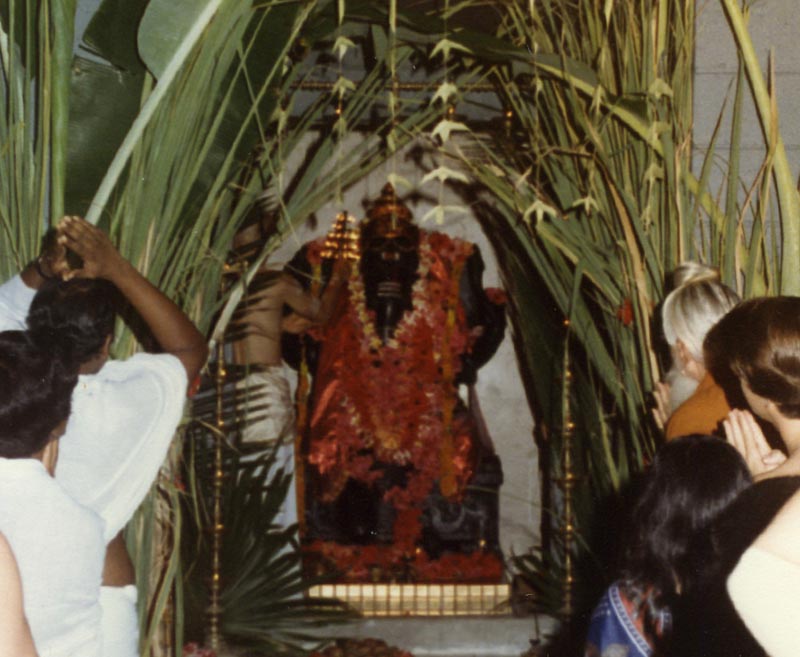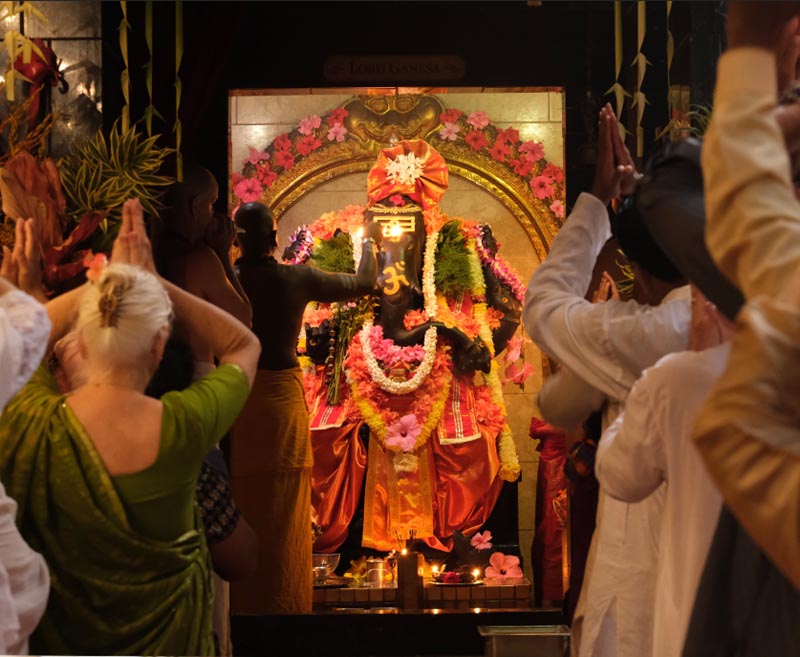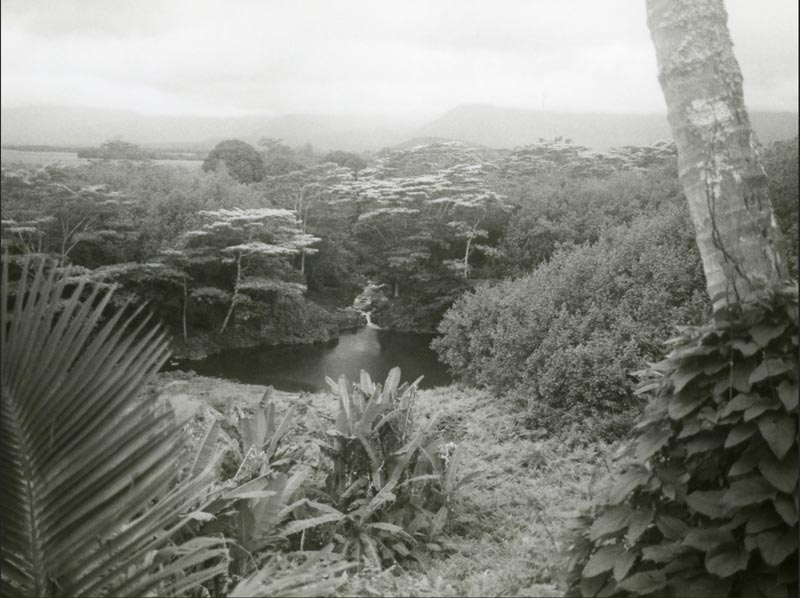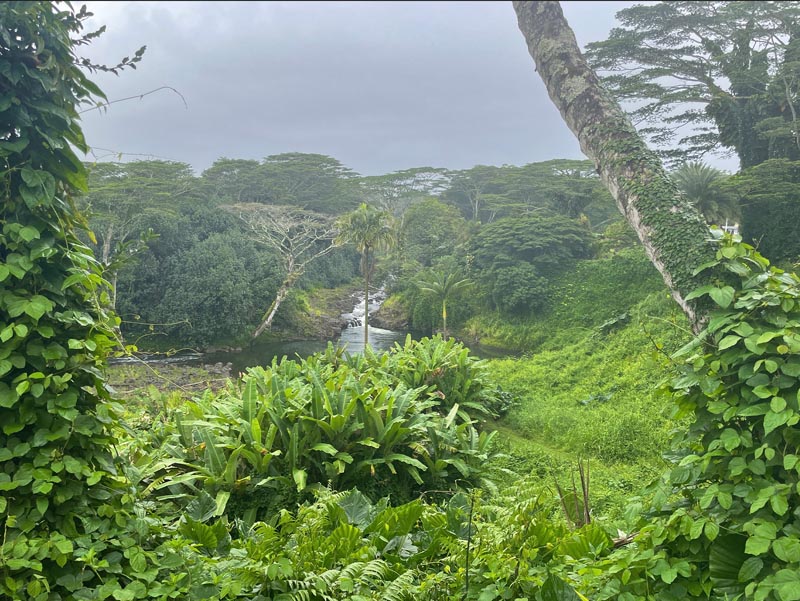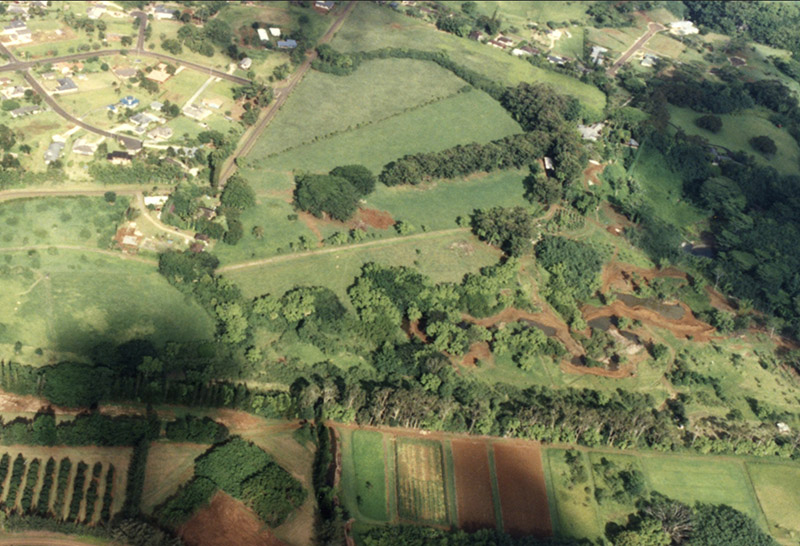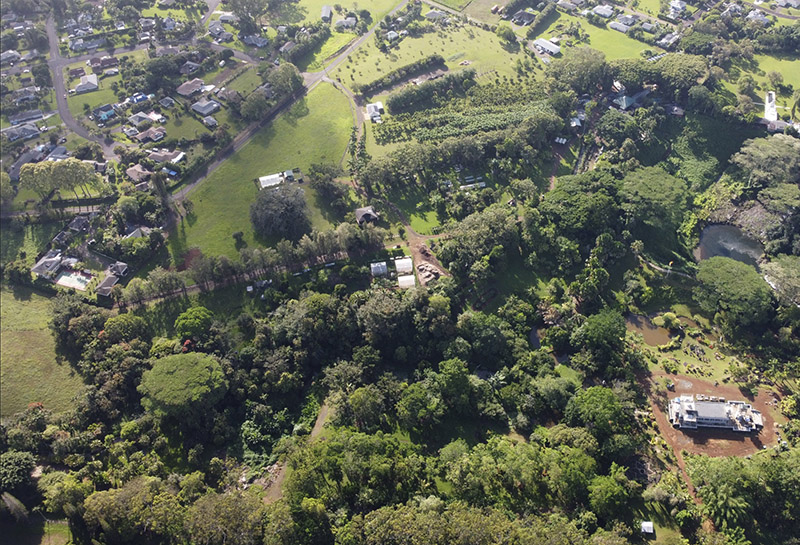Kadavul Temple Tank Walkway

Jai Ganesha!
Recently, thanks to the hard work of our hired workers Doug and Jim, the walkway around the Kadavul Temple Tank has been greatly improved! For some time now the walkway had sported the older painted concrete that lays beneath are other paths. We decided it was finally time to add quartzite as you'll find everywhere else around the temple. After a few weeks of construction the walkway is complete and our visitors can now enjoy a wonderful new temple tank experience! Aum.
Unity at the Mountain Top
A talk by Satguru Bodhinatha Veylanswami, from our archives:
UNEDITED TRANSCRIPT:
Reading this morning from today's "Living with Siva" Lesson: Unity at the Mountain Top.
"If we return to our analogy of the mountain peak, the path to it, religion, would be likened to a well-trodden trail. There are many people all along the way to assist in times of need. There are also those few in each religion who have walked the entire path, reached the summit and can lead others along the way. Those pursuing yoga, philosophy or mysticism separate from the foundation of day-to-day religion are like lone climbers treading through unknown territory, up unknown slopes. Theoretically they too can reach the summit. But realistically they do not. Mountain storms, unforeseen precipices, dead ends and untold other dangers and detours eventually claim such would-be seekers. Many fall into the crevice of intellectual rigidity and arrogant argumentativeness."
That doesn't sound like a very pleasant place, does it? "Falling into the crevice of intellectual rigidity and arrogant argumentativeness."
Now that's one of the advantages of following a path of religion that involves theism or worship is we can avoid that crevice. In other words, if there's not enough devotional practice in what we're doing, it's easy to rely too much upon the intellect, too much upon philosophy, particularly for men, more prone to that. And then once you become very good a philosophy, you know you're very good at philosophy and guess what: We are in the crevice of arrogant argumentativeness. Welcome! Welcome to that crevice.
"The path of dharma, which is India's word for religion, is the sure and proven path. They call it the eternal path, Sanatana Dharma. True religion does not discount mystic experience. Every true religion has produced its mystics. And it is here where religious unity is realized. The Zen master, Christian master, master of Kabala, Sufi mystic, Shinto shaman, Hindu sage and Taoist recluse can all speak of unity. They can all look into each others' eyes and see no difference, but only oneness of spirit. For there is but one mountain peak that rises above the clouds. And all true seekers, regardless of their religion must find their way to this one summit within themselves, sometimes transcending the religion of their birth. In mystic experience lies the unity of all religions."
So, what Gurudeva's pointing out is it's true; there's a oneness of religion in the sense of what successful mystics eventually experience. But we can't turn around and say: Well, all religions are one, all religions are the same, therefore, I can really create my own religion here, go about the spiritual path any way I want to. That's how some individuals interpret this idea of mystical oneness. But, as is pointed out in the first paragraph, it's really difficult; it's making the path extremely difficult to actually get to the top of the mountain peak when we but creating our own religion instead of following one of the established traditions.
"Vedanta is an attempt to describe the experiences of the mystic. But how many actually attain to these final heights of realization? Many speak of them, but in the final analysis, too few ever reach them, for very few are willing to go through the rigorous efforts of purification. Few are willing to face each fault and weakness in their nature. Few are willing to take their scriptures, their spiritual leader's words and their own intuitive knowing to heart and apply and practice their religion every day, every hour, every minute. But this is what it takes. It takes this kind of dedication, this kind of unrelenting effort."
So that's a common theme in Gurudeva's writings and therefore, in my talks, just making sure we eliminated this western concept which divides life into sacred and secular. This part of my day: that's my sacred day, that's when I'm advancing spiritually. This part of my day: that's when I do my work. It has nothing to do with advancing spiritually. Well that kind of vision is not the approach to Hinduism that Gurudeva takes. He integrates; we don't divide. Our religious practices should permeate everything we do throughout the day. As he says: "...practice their religion every day every hour, every minute."
So it doesn't' mean we're sitting meditating 16 hours a day, it doesn't mean we're doing puja 16 hours a day. It means, somehow no matter what we're doing, we're spiritualizing it. We're using that action; we're approaching that action in a way that the way we accomplish it advances us spiritually. For example, just in finishing a difficult task, one that we would tend to not quite finish. You know, we'd leave it three quarters done and call it good enough. But to muster up that will-power and we just want to take a rest, take a break and finish it and do it a little better than we originally envisioned. That is turning a task and no matter how mundane, into an act that advances us spiritually because we've strengthened our willpower in the accomplishment of it. So that kind of simple integration whereby we don't divide. That's what Gurudeva's talking about.
"The mystic whom we see poised on the peak of God Realization is the same man who once faced each experience that you now do. He didn't skip them or go around them. He had to deal with the same doubts, the same fears and the same confusion. He had those same experiences where all seems against you, and you seem so alone and ask, 'Why am I the one who has these unsolvable problems, these totally confusing situations?' He didn't give in to that abyss of doubt. He threw himself at the feet of God when all seemed beyond hope. And hope appeared. He persevered, tried his best, made the decisions that made the most sense in spite of unclarity--and all the while continued his sadhana, continued his spiritual practices, until one by one the veils of confusion faded and clarity became constant. He is the man who strived so hard on the little things in life, as well as on the great challenges. He simply did--not spoke of, but did--what you know you should do. We are the carvers of our own future. God's grace, His love, is always blessing us in our efforts. "
Well again, this is a common division in life. We think that the challenges--which we prefer to call problems, right?. The challenges, the problems that we're facing in our family, in our workplace, in our community are distractions from making spiritual progress. So, these, this is what's keeping me from progress. All these things are constantly going on. How can I make spiritual progress?
Well again, that's dividing life. It's saying that these challenges we're facing had nothing to do with spiritual progress. Well what Gurudeva says: What we do all do all day long should be a source of progress. Therefore, we have to get up our courage and our willpower and figure out how to work through it. And in doing that we make spiritual progress. Again, by not dividing life but by facing what comes to us naturally and figuring out how to work with it; how to make the best of it.
And when we do all that we don't get stuck, as Gurudeva calls it: The "abyss of doubt," that's next to this crevice of arrogance. "Crevice of intellectual rigidity and arrogant argumentativeness" is next door to the "abyss of doubt."
So, how do we overcome doubt? Gurudeva says: "He threw himself at the feet of God when all seemed beyond hope. And hope appeared."
So, asking for God's, asking for strength. You know, when we don't feel strong and we feel we... That's why we have our theism. That's why we have the temple. We can come to the temple and ask for strength. And the strength to handle this challenge in my life. Please help me find that strength, right? We can!
That was today's Living with Siva. Not alone counting the Dancing with Siva or the Merging.
Wonderful day.
Path of the Saiva Satgurus
Aum Namah Sivaya
Recently Rajkumar Manickam in Colorado has put the finishing touches on this wondrous, photo-rich presentation of the Path of the Saiva Satgurus. This path is a visual history of our lineage of gurus which extends back 2,200 years, and beyond, to Maharishi Nandinatha and his eight disciples—Sanatkumara, Sanakar, Sanadanar, Sananthanar, Sivayogamuni, Patanjali, Vyaghrapada and Tirumular. After Tirumular, the first known satguru of this lineage in recent history was the Rishi from the Himalayas (ca 1770-1840). From him the power was passed to Siddha Kadaitswami of Bangalore (1804-1891), then to Satguru Chellappaswami (1840-1915), then to Siva Yogaswami (1872-1964), then to Sivaya Subramuniyaswami (1927-2001), who ordained Bodhinatha Veylanswami to carry forth his mission.
Jai to the Kailasa Parampara!
View it at this link or click below.

Our Sunset for the Phase
Aum Namah Sivaya
Today is the last day of our monks' phase, so they'll be heading into two days of retreat. We'll see you again soon, but for now we leave you with this profound quote from Yogaswami:
"Existence is a value which is always judged by a conscious being.
The absence of consciousness cuts at the root of all value including existence.
Thus the very perception of phenomena is the proof of Brahman."
Raising the Flag for the 2021 Jivana Ritau

Jai Ganesha!
Today is the first full day of our new season, the Jivana Ritau. Early yesterday morning, the monastics gathered in Kadavul Temple for a homa, a Vedic fire ceremony, and then proceeded out the the aadheenam's flagpole to fly the dvaja for the new season.
Excerpts from Saiva Dharma Shastras about the this time of year:
"Beginning with Hindu New Year in mid-April, three seasons of the year divide our activities into three great needs of humankind the learning of scripture in the first season, Nartana Ritau; the living of culture in the second season, Jivana Ritau; and the meditating on Siva in the third season, Moksha Ritau. Thus we are constantly reminded that our life is Siva's life and our path to Him is through study, sadhana and realization. In ritau one, we teach the philosophy; in ritau two, we teach the culture; and in ritau three, we teach meditation.
During Jivana Ritau, the rainy season, from mid-August to mid-December, Living with Siva: Hinduism's Contemporary Culture is the primary text. The key word of this season is work. The colors are rust, copper-maroon and all shades of red rust for earthy preservation, copper-maroon for fulfillment and red for physical energy. The Aadheenam's flag pole flies the rust-colored dhvaja, symbolizing environmental care. Copper-maroon and all shades of red adorn our smaller flags. This is the season of honoring and showing appreciation for those in the vanaprastha ashrama, life's elder advisor stage. The focus is on preserving what has been created, manifesting goals and fulfilling plans made in the past. Inwardly the emphasis is on direct cognition and caring for the practical details of the external world. Practicality is a word much used this season."
Through the Lens – August 22, 2021

Aum Namah Sivaya
This week our taskforcer Alexander has been working in the Media Studio with the Ganapati Kulam. Today he went on an adventure with our Fujifilm camera and documented the many little things that caught his eye.
Happy Sadhu Paksha!
This phase our monks find themselves in their second week of Sadhu Paksha. This is a time when the mathavasis change their usual morning routine and instead enjoy their sadhana unstructured, walking and meditating among nature. After Sadhu Paksha we will celebrate our change of seasons as we transition into the Jivana Ritau. Following the example of our monks, these few weeks are a great time for you to change your own daily routine and spend some time with nature. Today our drone captures the monastery grounds at sunrise during our morning sadhana hours. Aum.
Working in the Pillaiyar Kulam
This last month, our taskforcer Alexander has been working with the Pillaiyar Kulam. This kulam is responsible for finances, shipping, Mini Mela care and management, legal documents, endowments, cows, networks, IT and so much more. Apart from helping with the day-to-day items, and most recently helping in the Mini Mela gift shop, Alexander has been enjoying a few other fun projects. Aum.
From Our Gurus' Teachings
Archives are now available through 2001. Light colored days have no posts. 1998-2001 coming later.

